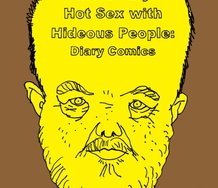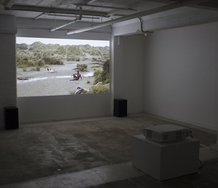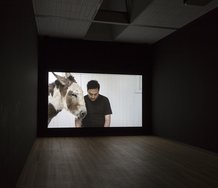Jessica Hubbard – 20 May, 2015
We come to this work in person, as spectator, as participant, in the Adam Art Gallery. Part of it is housed in a room used to project moving images. Usually pitch black, a small window has been uncovered and an indirect light falls through it onto the windowsill, the object on the windowsill and the object in the room, a lead dipped nailgun mounted on a pole. The light is not enough to reach the entire room and gently highlights the objects. The light is beautiful, soft and blue, reminiscent of Dutch masters or contemporary cinema.
Wellington
Richard Frater
Living Cities 2011-
Sound mixed by Richard Francis
25 April - 28 June 2015
At the heart of Andrei Tarkovsky’s film Stalker is a philosophical point about openheartedness. It pits the passion and belief of the stalker against the rationalism and blindness of the professor and the writer. As in Stalker this work requires the engagement and open mind of the spectator. It requires a viewer who is prepared to immerse themselves into the heart of the work and become part of it, a spectator that is prepared to be directed into a certain type of cinematic experience.
The work starts as a kind of documentary. The artist comes to back to Wellington from Berlin over a series of years for handfuls of time. The artist investigates his city anew through his friends. Wellington is many cities, a city of shops, civic spaces, government agencies, schools and universities, and suburbs. It is people taking the bus, driving their cars, riding their bikes. But the city the artist explores is a city of walking, a city of bush and tracks that run like parallel worlds through the urban and suburban zones. We share the tracks and the suburbs with native birds, with groups of tui, with gangs of kaka, with waxeyes and fantails. The birds are brought to us by the sanctuary and they make our city unique. We love them so.
So the artist learns more about the kaka and learns about the interaction of the kaka with the human inhabitants of the city. The kaka is big enough and exotic enough to still be a joyful, although relatively common sight, to us living here in the suburbs of Wellington. The artist knows volunteer kaka feeders and counters. He learns that many kaka land on roofs of suburban houses where some of us throw them food and where their destruction, the pulling up of nails, leads to their destruction, the ingestion of the lead in the nails. The kaka swallows the poison and then shits it out into the sanctuary to spread but more significantly the lead bonds with calcium and leaches into their calcium lined eggs and poisons the next generation. It is a small scale reflection of a wider human- wrought disaster.
And that is the point. The artist takes these elements and decides he wants to make a film in this film-wrought city of Wellington. No, actually he wants to make a cinematic experience. And this is where the work begins again - with filmic elements.
In his artist’s talk Richard Frater references Tarkovsky‘s Stalker. Curiously the making of Stalker in an old chemical factory in Estonia is often credited with poisoning many of the crew, in the sense that it is said to have contributed to an incidence of cancer amongst them and perhaps even led to the premature death of Tarkovsky himself.
The trailer for Living Cities 2011- can be seen online. A man sits at the window of a room high up and looking over the Eastern hills. He may be watching something.
We come to this work in person, as spectator, as participant, in the Adam Art Gallery. Part of it is housed in a room used to project moving images. Usually pitch black, a small window has been uncovered and an indirect light falls through it onto the windowsill, the object on the windowsill and the object in the room, a lead dipped nailgun mounted on a pole. The light is not enough to reach the entire room and gently highlights the objects. The light is beautiful, soft and blue, reminiscent of Dutch masters or contemporary cinema.
There is an elegance to this scene. It has the polish of the gallery, a polish brought by the architecture and the light, a polish that reflects on the objects the artist has brought in: the nailgun, and a mortar and pestle. This part of the work seems to represent a kind of ideal space, the way we want to see ourselves in relationship to the kaka. The spectator/participant is framed and flattered by the light. What is an art gallery but a clean, dry, blank space, an idealised space, a very human space, a polished perfection? This space is soothing for the participant.
And then we must go to the gallery reception and get the map and the key to the next scene, the other part of the work. We must walk through hoards of students eating lunch or smoking or waiting for the bus. We must walk past a construction site with dust, ply, and hard-hatted construction workers breathing it in with earmuffs worn down around their necks. We must walk through a tree laden suburb to a deserted house, unlock the heavy door to the house and slip in before it closes on us. Now we are in the next constructed scene. The other scenes along the way were incidental and out of the control of the artist - even if they were fitting.
We are only allowed in certain rooms in the house - for the other rooms are out of bounds. The house is damp and mouldering, the floors uneven, and each room contains a bare mirror screwed to the wall, frameless and undressed. The windows are open, possibly in an attempt to air the rooms. Perhaps this is a mistake on the part of the artist/director/gallery, as the unhealthy feeling of the mouldering air would have added to the overall feeling of ill health that this scene induces.
The artist has introduced soundscapes and objects. The soundscape in one room primarily registers as the sounds of the bird sanctuary and in the other, settles loudly and completely on the edges of discomfort; the sound equivalent of nails on a blackboard. Eventually it makes me feel sick. Remember this is a documentary about lead poisoning. It was easy to forget that, in the nice clean gallery - but this place reminds us.
It is these juxtapositions, these scenes both intended and unintended that introduce the story, the polished human space, the poisoned human space, the human world of construction and destruction - and tree-lined suburb that sits between them full of good intention. These juxtapositions begin to tell this story; this story about the kaka, this story about us. Is it time to open our minds and step into this story? We are already there.
Jessica Hubbard
 Advertising in this column
Advertising in this column Two Rooms presents a program of residencies and projects
Two Rooms presents a program of residencies and projects



This Discussion has 0 comments.
Comment
Participate
Register to Participate.
Sign in
Sign in to an existing account.